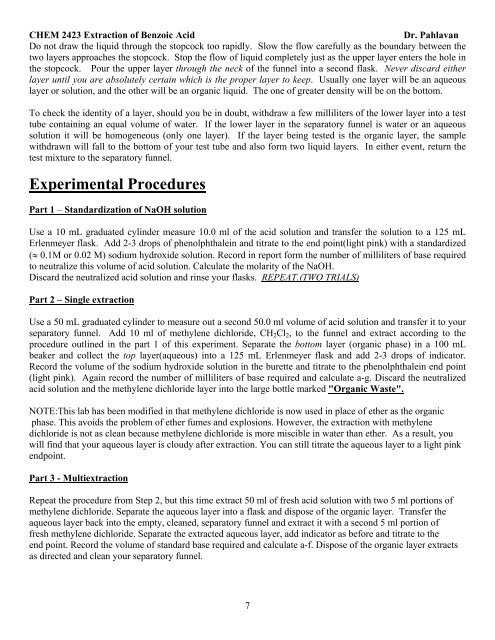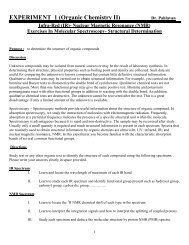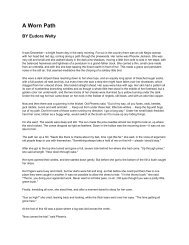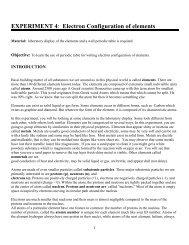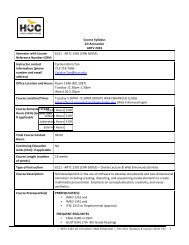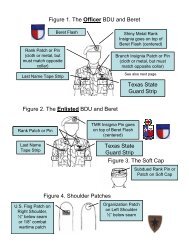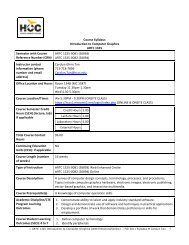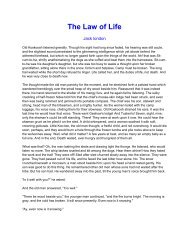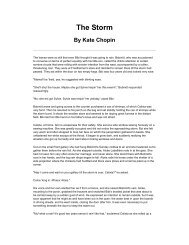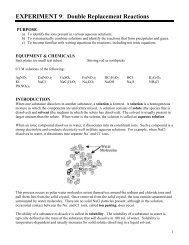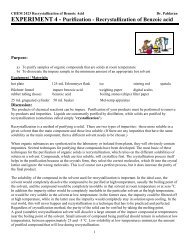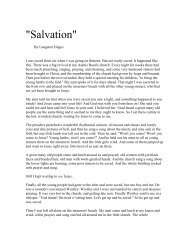EXPERIMENT 6 - Extraction
EXPERIMENT 6 - Extraction
EXPERIMENT 6 - Extraction
- No tags were found...
Create successful ePaper yourself
Turn your PDF publications into a flip-book with our unique Google optimized e-Paper software.
CHEM 2423 <strong>Extraction</strong> of Benzoic AcidDr. PahlavanDo not draw the liquid through the stopcock too rapidly. Slow the flow carefully as the boundary between thetwo layers approaches the stopcock. Stop the flow of liquid completely just as the upper layer enters the hole inthe stopcock. Pour the upper layer through the neck of the funnel into a second flask. Never discard eitherlayer until you are absolutely certain which is the proper layer to keep. Usually one layer will be an aqueouslayer or solution, and the other will be an organic liquid. The one of greater density will be on the bottom.To check the identity of a layer, should you be in doubt, withdraw a few milliliters of the lower layer into a testtube containing an equal volume of water. If the lower layer in the separatory funnel is water or an aqueoussolution it will be homogeneous (only one layer). If the layer being tested is the organic layer, the samplewithdrawn will fall to the bottom of your test tube and also form two liquid layers. In either event, return thetest mixture to the separatory funnel.Experimental ProceduresPart 1 – Standardization of NaOH solutionUse a 10 mL graduated cylinder measure 10.0 ml of the acid solution and transfer the solution to a 125 mLErlenmeyer flask. Add 2-3 drops of phenolphthalein and titrate to the end point(light pink) with a standardized(≈ 0.1M or 0.02 M) sodium hydroxide solution. Record in report form the number of milliliters of base requiredto neutralize this volume of acid solution. Calculate the molarity of the NaOH.Discard the neutralized acid solution and rinse your flasks. REPEAT.(TWO TRIALS)Part 2 – Single extractionUse a 50 mL graduated cylinder to measure out a second 50.0 ml volume of acid solution and transfer it to yourseparatory funnel. Add 10 ml of methylene dichloride, CH 2 Cl 2 , to the funnel and extract according to theprocedure outlined in the part 1 of this experiment. Separate the bottom layer (organic phase) in a 100 mLbeaker and collect the top layer(aqueous) into a 125 mL Erlenmeyer flask and add 2-3 drops of indicator.Record the volume of the sodium hydroxide solution in the burette and titrate to the phenolphthalein end point(light pink). Again record the number of milliliters of base required and calculate a-g. Discard the neutralizedacid solution and the methylene dichloride layer into the large bottle marked "Organic Waste".NOTE:This lab has been modified in that methylene dichloride is now used in place of ether as the organicphase. This avoids the problem of ether fumes and explosions. However, the extraction with methylenedichloride is not as clean because methylene dichloride is more miscible in water than ether. As a result, youwill find that your aqueous layer is cloudy after extraction. You can still titrate the aqueous layer to a light pinkendpoint.Part 3 - MultiextractionRepeat the procedure from Step 2, but this time extract 50 ml of fresh acid solution with two 5 ml portions ofmethylene dichloride. Separate the aqueous layer into a flask and dispose of the organic layer. Transfer theaqueous layer back into the empty, cleaned, separatory funnel and extract it with a second 5 ml portion offresh methylene dichloride. Separate the extracted aqueous layer, add indicator as before and titrate to theend point. Record the volume of standard base required and calculate a-f. Dispose of the organic layer extractsas directed and clean your separatory funnel.7


